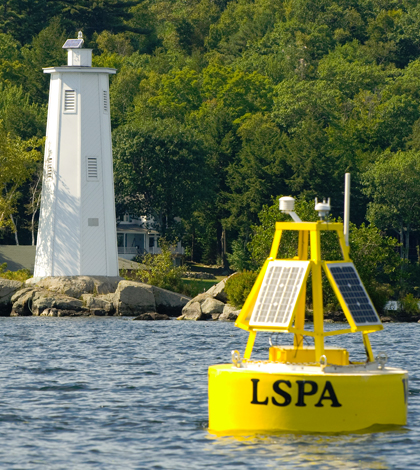Lake Sunapee data buoy utilizes NexSens T-Node temperature string

Lake Sunapee in western New Hampshire is known for its exceptionally pure water quality. Much of the water flows out of cold underground springs rising from a bedrock aquifer. The lake has eight islands, several peninsulas and lake fingers, and seven beach areas, meaning there’s room for many to cherish its beauty.
In order to protect this esteemed natural resource, the member-supported, non-profit Lake Sunapee Protective Association carefully monitors the lake’s water quality. The LSPA was founded in 1898 and is New Hampshire’s oldest environmental association.
The organization has been testing water quality in Lake Sunapee since 1950. A few years ago, a real-time water quality and weather data buoy was deployed in the lake to assist with monitoring efforts.
Data is wirelessly transmitted from the buoy every ten minutes, and it is part of the Global Lake Ecological Observatory Network, or GLEON.
Instruments on the buoy measure air temperature, wind speed and direction, humidity, photosynthetically active radiation, dissolved oxygen, and temperature.
Temperature is measured every 2-3 meters down through the water column to provide a comprehensive lake temperature profile. The LSPA, however, recently needed to replace the buoy’s temperature sensor string. Officials were impressed with the rugged hardware construction of NexSens T-Node water temperature sensors and chose them as the replacement.
Each T-Node includes a completely sealed, extremely precise temperature measurement system with top and bottom waterproof connectors. The T-Nodes have a range of 0-50 ºC and an accuracy of +/-0.1 °C for high-precision measurements. T-Nodes can withstand underwater deployments as deep as 100 meters.
The T-Nodes connect with underwater cabling to build a string of measurement sensors that are suspended vertically in the water column. (T-Nodes can also be strung horizontally along the seabed.)
The LSPA’s data logging equipment needed an SDI-12 output interface to read the temperature profile data, so a NexSens SDL submersible data logger was utilized as an SDI-12 output controller.
Unlike many data loggers, the NexSens SDL can also function in a slave mode, allowing it to output data in SDI-12 or Modbus format to third-party data loggers. With the SDL in place, temperature data from the T-Nodes can be read by the buoy’s Campbell Scientific data logger and transmitted wirelessly along with other environmental data to a remote computer.
Image Credit: http://en.wikipedia.org/wiki/File:LSPA_GLEON.jpg





0 comments